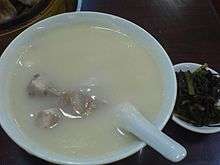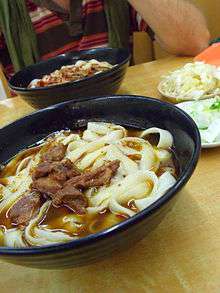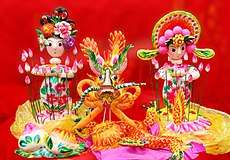Shanxi cuisine
| Shanxi cuisine | |||||||
| Chinese | 山西菜 | ||||||
|---|---|---|---|---|---|---|---|
| |||||||
| Jin cuisine | |||||||
| Traditional Chinese | 晉菜 | ||||||
| Simplified Chinese | 晋菜 | ||||||
| |||||||
 |
| This article is part of the series |
| Chinese cuisine |
|---|
|
|
Ingredients and types of food |
|
Shanxi cuisine, or Shan cuisine, is derived from the native cooking styles of Shanxi Province in China. It is famous for noodles, fried flatbread (da bing) and sour tastes. The cuisine is also famed for using its locally produced vinegar, just like in Huaiyang cuisine, but the flavour is totally different.
Generally speaking, Shanxi cuisine is not well known to people outside the region. This is partially because Shanxi is less populated than other provinces in China. Being a very traditional region where the lifestyle of locals has not been modernised, many outsiders find Shanxi cuisine too authentic and traditional.
While pork and chicken are common in Shanxi, one of the most popular meat sources is lamb. Goat, and sheep offal is also often used. For example, lamb soup is usually cooked with livers, stomach and other offal. As a traditional area with strong cultural connections to Northwest Asian nomadic nations and minorities, the use of lamb in Shanxi cuisine presents a unique fusion of the culinary traditions of North Chinese minoritiy and Han Chinese. For example, using ground lamb and carrots as a dumpling filling, is something that is not found in any other Chinese cooking styles. Ground pork with chopped dill is another popular dumpling filling.
The main saples reflect the crops commonly grown in Shanxi: millet, sorghum, and wheat. While pork, mushrooms, potatoes and turnips are frequently used in dishes.
Styles
Shanxi cuisine comprises three styles:
- Northern Shanxi style: Represented by dishes from Datong and Mount Wutai, with emphasis on colour and oil.
- Southern Shanxi style: Represented by dishes from Linfen and the Grand Canal regions, specialising in seafood, despite the fact that Shanxi is a landlocked province.
- Central Shanxi style: Represented by dishes from Taiyuan, which presents a mainstream cooking style compared to both the northern and southern regions of the province. Before the 1970s, as local cuisine and professional cooking had not been influenced by Cantonese and Sichuan styles, Taiyuan cuisine contained a number of noodle dishes, Chinese Muslim dishes, local hot pot dishes, and meat dishes using fresh water seafood and lamb. The region is especially famous for its knife-shaven noodles (dao xiao mian).
Shanxi mature vinegar
Shanxi mature vinegar, also called Shanxi lao chencu (山西老陈醋; 山西老陳醋; Shānxī lǎo chén cù) in Chinese, is a special type of vinegar produced in Shanxi Province. Based on the techniques used to prepare the vinegar, it should be more accurately called "aged Shanxi vinegar" or "extra aged vinegar". Some of the methods used in brewing the vinegar have been considered intellectual properties and are under the protection of Chinese laws.[1] It is a famous product of the region, and is produced primarily in Qingxu County, a vicinity of the provincial capital of Taiyuan. The Shanxi Vinegar Culture Museum has been built there.[2][3] Local Taiyuan residents, especially those who have lived there for generations, prefer Donghu Mature Vinegar (东湖老陈醋; 東湖老陳醋; donghu) produced by Shanxi Mature Vinegar Group, which is the largest mature vinegar manufacturer in China.[4] There is also Ninghuafu Yiyuanqing (宁化府益源庆; 寧化府益源慶; Nínghuàfǔ Yìyuánqìng), a brand of vinegar produced by the Yiyuanqing Company in the old downtown area of Taiyuan.
In the United States, some Asian grocery stores sell Shanxi mature vinegar. The common suppliers are Shanxi Mature Vinegar Group,[5] a China Time-Honored Brand company since 1368,[6] and Shuita Brand (水塔牌; Shuǐtǎ pái), a brewing company located in Qingxu County.
Notable dishes
| English | Traditional Chinese | Simplified Chinese | Pinyin | Image | Notes |
|---|---|---|---|---|---|
| Cat's ear | 貓耳朵 | 猫耳朵 | māo ěrduō | Noodles shaped like a cat's ears. Similar to orecchiette. | |
| Youmian kaolaolao | 莜面栲栳栳 | 莜面栲栳栳 | Yóu miàn kàolaolao | Oat flour noodle rolls shaped like biscuit rolls | |
| Fu Shan mutton soup | 傅山頭腦 | 傅山头脑 | Fù Shān tóunǎo |  | A soup made from lamb, rice wine, yam and other spices. Despite its name, it has nothing to do with brains. It is named after Fu Shan (傅山; 1607–1684), a scholar and artist from Taiyuan. It is traditionally enjoyed during winter and is said to be nutritious. |
| Datong knife-shaved noodles | 大同刀削麵 | 大同刀削面 | Dàtóng dāo xiāo miàn |  | Willow leaf shaped noddle made by sharp sheet iron. |
| Liangpi | 涼皮 | 凉皮 | liáng pí |  | Cold rice noddle with spicy chili oil. |
| Minbagu | 抿八股 | 抿八股 | mǐn bā gǔ | ||
| Pingyao beef | 平遙牛肉 | 平遥牛肉 | Píngyáo niúròu | Beef specially produced in Pingyao County | |
| Shanxi crispy duck | 山西香酥鴨 | 山西香酥鸭 | Shānxī xiāng sū yā | The duck is steamed first and then pan-fried. This creates a crispy and rich taste without making the duck meat too greasy. | |
| Soy cheese steamed pork | Pork is stir-fried first, then steamed in a big bowl together with red salty soy cheese curd (similar to the one used in Beijing cuisine), ginger and garlic. When done, the pork has a creamy, soft, lightly sweet and richly savoury taste from the soy cheese and pork fat. The pork is thinly sliced and served with fresh herbs.[7] | ||||
| Sweet and sour meatballs | 糖醋丸子 | 糖醋丸子 | táng cù wánzǐ | ||
| Taigu cake | 太谷餅 | 太谷饼 | Tàigǔ bǐng | A type of pastry from Taigu County | |
| Huamo | 花饃 | 花馍 | huāmó |  | A type of decorated, specially shaped mantou. |
References
- ↑ "Photograph" (JPG). Csn.com.cn. Retrieved 15 January 2015.
- ↑ "China's First Vinegar Museum Opens". English.peopledaily.com. Retrieved 15 January 2015.
- ↑ "Vinegar Culture Museum Opens in Shanxi". English.peopledaily.com. Retrieved 15 January 2015.
- ↑ "Shanxi Mature Vinegar Group". Shanxi.chinadaily.com.cn. Retrieved 15 January 2015.
- ↑ "Chefs Choice, Natural Brewed Mature Vinegar, Rice Vinegar direct from China (Mainland)". Sxvinegar.en.alibaba.com. Retrieved 15 January 2015.
- ↑ Archived July 14, 2014, at the Wayback Machine.
- ↑ 360 Cooking, Yong Le etc. eds., 2nd Edition, 2000, by Shanxi Publishing House of Science and Technology. (Original text is in simplified Chinese only)